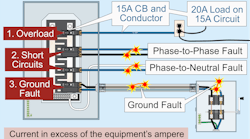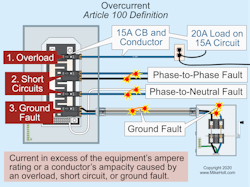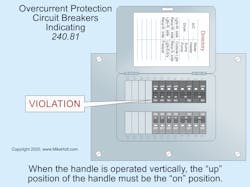Courtesy of www.MikeHolt.com. Based on the 2020 NEC.
Article 240 provides the requirements for overcurrent protection and selecting/installing overcurrent protective devices (OCPDs) — typically circuit breakers or fuses. Overcurrent exists when the current exceeds the ampere rating of equipment or the ampacity of a conductor due to an overload, short circuit, or ground fault [Art. 100] (Fig. 1).
Overloads, shorts, and faults
These terms are not interchangeable:
- Overload. A condition where equipment or conductors carry current exceeding their current rating [Art. 100]. A fault, such as a short circuit or ground fault, is not an overload. An example of an overload is plugging two 12.50A (1,500W) hairdryers into a 20A branch circuit.
- Short circuit. The unintentional electrical connection between any two normally current-carrying conductors of an electric circuit, either line-to-line or line-to-neutral.
- Ground fault. An unintentional, electrically conducting connection between a phase conductor of a circuit and the normally non-current-carrying conductors, metal enclosures, metal raceways, metal equipment, or the earth [Art. 100]. When a ground fault occurs, dangerous voltages are present on metal parts until the circuit OCPD opens and clears the fault.
OCPD basics
OCPDs protect conductors and equipment. The general rule for overcurrent protection is that conductors must be protected per their ampacities at the point where they receive their supply [Sec. 240.4 and Sec. 240.21].
The asterisks next to the small conductor sizes in Table 310.16 refer to a footnote directing you to Sec. 240.4(D). That Section contains the general rules for small conductors that limit the rating of the OCPDs protecting them. Table 240.4(G) lists Articles in the Code that modify the rules of Sec. 240.4(D). There are also several rules allowing tap conductors (with much lower ampacities than the OCPD protecting them seems to allow) in specific situations [Sec. 240.4(E)].
The tripping action of an OCPD during an overload is based on a “time-current-curve,” which essentially means that the higher the current, the faster the device will trip. Because of this “time-current-curve,” conductors with lower ampacities than the OCPD protecting them may seem to break the rules, but the overcurrent condition will be present only for a very short and safe amount of time.
An OCPD must be capable of opening a circuit when an overcurrent situation occurs, and must also have an interrupting rating sufficient to avoid damage in fault conditions [Sec. 110.9].
Overcurrent protection must be provided for each phase conductor at the point where the conductors receive their supply [Sec. 240.21] except as permitted by (A) through (H).
Conductors
Except as permitted by Sec. 240.4 (A) through (G), conductors must be protected against overcurrent per their ampacity after ampacity correction and adjustment as specified in Sec. 310.14.
For example, you can use the next higher standard rating of OCPD (above the ampacity of the phase conductors being protected) shown in Table 240.6(A), if all the following conditions are met [Sec. 240.4(B)]:
(1) The conductors are not part of a branch circuit supplying more than one receptacle for cord- and plug-connected loads.
(2) The ampacity of a conductor, after the application of ambient temperature correction [Table 310.15(B)(1)], conductor bundling adjustment [Table 310.15(C)(1)], or both, does not correspond with the standard rating of a fuse or circuit breaker in Sec. 240.6(A).
(3) The next higher standard OCPD rating from Sec. 240.6(A) does not exceed 800A.
Let’s run through an example to show you how this works.
Question: Per Table 310.16, what is the maximum size OCPD that can be used to protect 500kcmil conductors where each conductor has an ampacity of 380A at 75°C (Fig. 2)?
Answer: A quick check of Sec. 240.6(A) shows that you should choose a 400A OCPD.
Table 240.6(A) shows the standard ratings in amperes for fuses and inverse time circuit breakers. You can also use fuses and inverse time circuit breakers with nonstandard ampere ratings.
The ampere rating of an adjustable trip circuit breaker:
- without restricted access to the adjusting means is equal to its maximum long-time pickup current setting [Sec. 240.6(B)].
- with restricted access to the adjusting means is equal to the adjusted long-time pickup current settings.
You can achieve restricted access by having the adjusting means password protected with the password accessible only to qualified personnel or by locating it behind [Sec. 240.6(C)]:
(1) Removable and sealable covers.
(2) Bolted equipment enclosure doors.
(3) Locked doors accessible only to qualified personnel.
Supplementary OCPDs
A “supplementary OCPD” is intended to provide limited overcurrent protection for specific applications and utilization equipment. This limited overcurrent protection is in addition to the overcurrent protection provided in the required branch circuit by the branch-circuit OCPD.
You cannot use supplementary OCPDs as the required branch-circuit OCPD, and a supplementary OCPD does not have to be readily accessible [Sec. 240.10].
Phase conductor OCPD
Circuit breakers must automatically open all phase conductors of the circuit during an overcurrent condition, except as permitted in Sec. 240.15(B)(1) through (3). For example, you can use individual single-pole circuit breakers rated 120V/240V with handle ties identified for the purpose for each phase conductor of a single-phase line-to-line load [Sec. 240.15(B)(2)].
Overcurrent protection must be provided for each phase conductor at the point where the conductors receive their supply except as permitted by Sec. 240.21(A) through (H).
Circuit breakers
Circuit breakers and switches containing fuses must be readily accessible and installed so the center of the grip of the operating handle (when in its highest position) is not more than 6 ft, 7 in. above the floor or working platform, except as noted in Sec. 240.24(A)(1) through (4).
You can’t place OCPDs:
- near easily ignitable materials [Sec. 240.24(D)].
- in bathroom areas [Sec. 240.24(E)].
- over steps [Sec. 240.24(F)].
When the handle of a circuit breaker is operated vertically, the “up” position of the handle must be the “on” position [Sec. 240.81]. See Sec. 240.33 and Sec. 404.7 (Fig. 3).
Circuit breakers have an interrupting rating of 5,000A unless marked otherwise. Always ensure the circuit breaker has an interrupting rating sufficient for the available fault current at the line terminals of the equipment. Using a circuit breaker with an inadequate interrupting current rating can cause equipment to be destroyed from a line-to-line or ground fault and result in death or serious injury. See Sec. 110.9 for more details.
Circuit breakers used to switch 120V or 277V fluorescent lighting circuits must be listed and marked “SWD” or “HID.” Circuit breakers used to switch high-intensity discharge lighting circuits must be listed and marked “HID.” [Sec. 240.83(D)]
A breaker might be single- or dual-voltage rated. You can use a circuit breaker with a:
- Single-voltage rating (e.g., 240V or 480V) if the nominal voltage between any two conductors (line-to-neutral or line-to-line) does not exceed the circuit-breaker voltage rating [Sec. 240.85].
- Slash-voltage rating (e.g., 120/240V or 277/480V) only if the nominal voltage of any one conductor to ground does not exceed the lower of the two values, and the nominal voltage between any two conductors does not exceed the higher value.
Where a circuit breaker is used on a circuit having an available fault current higher than the marked interrupting rating by being connected on the load side of an approved OCPD having a higher rating, the circuit breaker must meet the requirements of Sec. 240.86 (A) or (B), and (C). For example, the combination of the line-side overcurrent device and the load-side circuit breaker(s) is tested and marked on the end-use equipment (such as switchboards and panelboards).
Where the highest continuous current trip setting for which the overcurrent device in a circuit breaker is rated (or can be adjusted to) 1,200A or higher, Sec. 240.87(A) and (B) apply.
Documentation must be available to those authorized to design, install, operate, or inspect the installation as to the location and the method chosen to reduce the clearing time of the arc energy reduction circuit breaker(s) [Sec. 240.87(A)].
One of the means listed in Sec. 240.87(B)(1) through (7) must be provided and set to operate at less than the available arcing current. For example, you can use differential relaying or an arc reduction maintenance switch. Before deciding how to proceed, read Informational Notes 1 through 4.
If a method to reduce clearing time is required in Sec. 240.87(B), the arc energy reduction system must be performance tested when installed. Performance testing of an instantaneous element of the protective device must be conducted by a qualified person using a test process of primary current injection per the manufacturer’s recommended test procedures.
Avoiding errors
Remember, you are protecting conductors and equipment from an overload, short circuit, or ground fault. One of the double checks you should perform when reviewing your work is to compare the conductor ampacity to the OCPD rating. An error here should easily catch your attention.
Finally, study Art. 240 carefully so you can ensure you provide enough overcurrent protection in the correct location(s).
These materials are provided to us by Mike Holt Enterprises in Leesburg, Fla. To view Code training materials offered by this company, visit www.mikeholt.com/code.








